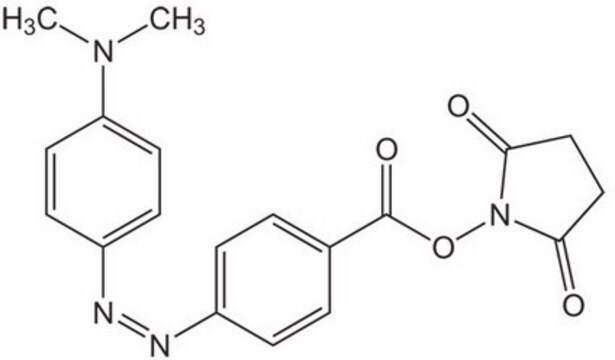77810
Atto 520 NHS ester
BioReagent, suitable for fluorescence, ≥90% (HPLC)
About This Item
Prodotti consigliati
Nome Commerciale
BioReagent
Saggio
≥90% (HPLC)
≥90% (degree of coupling)
Forma fisica
powder
Produttore/marchio commerciale
ATTO-TEC GmbH
λ
in ethanol (with 0.1% trifluoroacetic acid)
Assorbanza UV
λ: 526-532 nm Amax
Compatibilità
suitable for fluorescence
Metodo di rivelazione
fluorometric
Temperatura di conservazione
−20°C
Stringa SMILE
[O-]Cl(=O)(=O)=O.CCNc1cc2OC3=CC(=[NH+]\CC)\C(C)=CC3=C(CCC(=O)ON4C(=O)CCC4=O)c2cc1C
InChI
1S/C26H29N3O5.ClHO4/c1-5-27-20-13-22-18(11-15(20)3)17(7-10-26(32)34-29-24(30)8-9-25(29)31)19-12-16(4)21(28-6-2)14-23(19)33-22;2-1(3,4)5/h11-14,27H,5-10H2,1-4H3;(H,2,3,4,5)/b28-21-;
HVCUIKJJDQLPQR-AYYDQZPKSA-N
Cerchi prodotti simili? Visita Guida al confronto tra prodotti
Applicazioni
Note legali
Codice della classe di stoccaggio
13 - Non Combustible Solids
Classe di pericolosità dell'acqua (WGK)
WGK 3
Punto d’infiammabilità (°F)
Not applicable
Punto d’infiammabilità (°C)
Not applicable
Dispositivi di protezione individuale
Eyeshields, Gloves, type N95 (US)
Certificati d'analisi (COA)
Cerca il Certificati d'analisi (COA) digitando il numero di lotto/batch corrispondente. I numeri di lotto o di batch sono stampati sull'etichetta dei prodotti dopo la parola ‘Lotto’ o ‘Batch’.
Possiedi già questo prodotto?
I documenti relativi ai prodotti acquistati recentemente sono disponibili nell’Archivio dei documenti.
I clienti hanno visto anche
Articoli
Chromogenic and fluorogenic derivatives are invaluable tools for biochemistry, having numerous applications in enzymology, protein chemistry, immunology and histochemistry.
Il team dei nostri ricercatori vanta grande esperienza in tutte le aree della ricerca quali Life Science, scienza dei materiali, sintesi chimica, cromatografia, discipline analitiche, ecc..
Contatta l'Assistenza Tecnica.




![4-[4-(Dimethylamino)phenylazo]benzoic acid N-succinimidyl ester ≥98.0% (HPLC)](/deepweb/assets/sigmaaldrich/product/structures/120/235/500b5276-3ce2-43b7-9588-3883f13d4ff7/640/500b5276-3ce2-43b7-9588-3883f13d4ff7.png)

